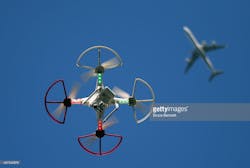Drone Nearly Induces Nightmare at 5,500 Feet
A drone came within 5 meters (16 feet) of a potentially catastrophic collision with an Air France jet landing at Paris Charles de Gaulle airport in the closest encounter yet between one of the remotely operated devices and a civil airliner.
The Airbus Group SE A320, which can carry 150 people, was arriving from Barcelona on Feb. 19 at a height of when the pilot saw the drone on the plane’s left-hand side. He quickly disconnected the autopilot and took avoiding action, according to the BEA, the French air-accident investigator.
France’s first full-blown probe of a drone near miss will now be initiated, it said. While drones are banned from flying near airports, such incidents are becoming common, with Britain recording 23 between April 11 and Oct. 4 last year. There were seven close shaves in the U.K. in December alone, and four of those were classified as involving a serious risk of collision.
As the number of so-called air-proximity incidents increases, pilots are lobbying for drones to be safely integrated into public airspace or banned, with the British Airline Pilots Association calling in January for a registration system so that rogue drone operators can be more easily traced and prosecuted.
OLD BETHPAGE, NY - SEPTEMBER 05: A drone is flown for recreational purposes as an airplane passes nearby in the sky above Old Bethpage, New York on September 5, 2015. (Photo by Bruce Bennett/Getty Images)
In one recent case, a drone came close to colliding with a Boeing Co. 737 climbing out of London Stansted, with other serious incidents recorded at Manchester, London City and London Heathrow, Europe’s biggest air hub.
The BEA said it didn’t know exactly how big the drone that buzzed the Air France plane was, nor who owned it, as it was glimpsed only by the pilot and not located afterwards.
France’s DGAC, equivalent to the U.S. Federal Aviation Administration, has created a Drones Council to conceive a defense system for errant or maliciously flown drones, and the Secretariat for Defense and National Security is reviewing bids to provide radar and scrambler systems to detect and even neutralize the devices if required.
Visit HERE for the Federal Aviation Administration's rules for Unmanned Aircraft Systems
Across Europe there are many thousands of hobby drones, some of which have been blamed for incidents involving civil aircraft, while in France alone there are more than 1,500 commercial drone companies operating craft that are generally about to fly higher and for longer than the “toy” devices.
France began regulating recreational drones in 2012, banning their use of over populated areas or above 150 meters and requiring the ground-based pilot to keep the craft within sight. Similar rules exist elsewhere, though they’re proving almost impossible to enforce with technology changing fast and no reliable way of tracking down errant operators.
A recent study by Aero Kinetics suggested that a drone ingested into an aircraft engine would be more likely than a bird strike to result in an uncontained failure, in which metal spewed from the turbine can compromise the aircraft’s integrity.
Do you think there should be stricter laws on drones? Let us know your thoughts in the comment section below!

